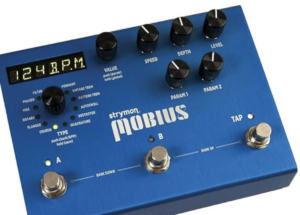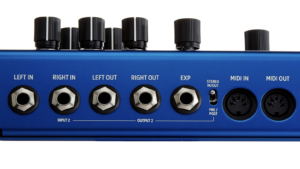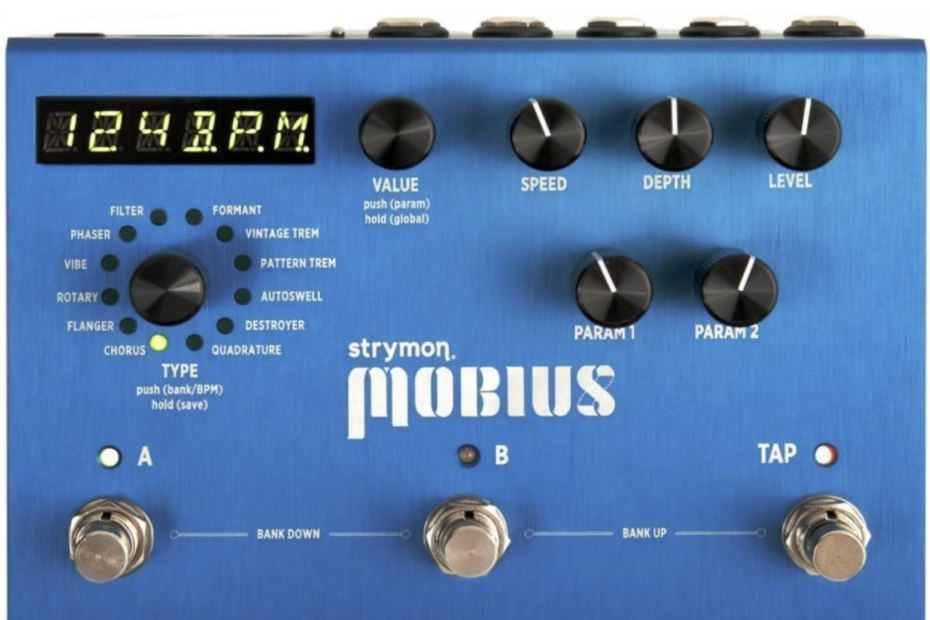The Strymon Mobius Multidimensional Modulation Pedal is a versatile and highly regarded modulation effects pedal that offers a wide range of modulation options for guitarists. Known for its exceptional sound quality and flexibility, the Mobius is designed to provide a comprehensive modulation experience in a single pedal.
The pedal features twelve different modulation effects, covering a spectrum of classic and experimental modulation sounds. These effects include Chorus, Flanger, Rotary, Vibe, Phaser, Filter, Formant, Vintage Trem, Pattern Trem, Autoswell, Destroyer, and Quadrature. Each effect category offers multiple variations and parameters, allowing users to fine-tune and sculpt their desired modulation tones.
Features of the Strymon Mobius
 One standout feature of the Mobius is its multidimensional processing capability, providing a dynamic and expressive modulation experience. The pedal responds to playing dynamics, allowing for nuanced control over the modulation effects. This responsiveness enhances the musicality of the modulation effects, making them feel more interactive and natural during performance.
One standout feature of the Mobius is its multidimensional processing capability, providing a dynamic and expressive modulation experience. The pedal responds to playing dynamics, allowing for nuanced control over the modulation effects. This responsiveness enhances the musicality of the modulation effects, making them feel more interactive and natural during performance.
The Mobius is equipped with powerful processing capabilities, ensuring high-quality sound with low noise and pristine signal integrity. It utilizes a 32-bit floating-point DSP and premium analog signal path components, contributing to the pedal’s studio-grade sound quality.
User-friendly controls and a clear, intuitive interface make it easy for guitarists to navigate the various modulation options. The pedal’s large LCD screen displays essential information, and the rotary encoder allows users to access and adjust parameters seamlessly.
In addition to its standalone operation, the Mobius is MIDI-compatible, offering extensive control options for integration into larger pedalboard setups or studio environments. Users can save and recall presets, connect expression pedals for real-time control, and synchronize the pedal with other MIDI devices.
Whether seeking lush chorus tones, swirling phasers, pulsating tremolos, or experimental modulations, the Strymon Mobius delivers a comprehensive range of high-quality effects. Its multidimensional processing, studio-grade sound, and versatile modulation options have made it a go-to choice for many guitarists seeking a top-tier modulation pedal for both live performances and studio recordings.
Also Read:
Eventide H90 MAX Harmonizer Multi Effects Pedal review
SONICAKE Multi Effects Processor Pedal
MOOER GE100 Multi-effects Guitar Processor Pedal Review
Digitech JMSXT JamMan : Looper Pedal Review
MXR Clone Looper Guitar Effects Pedal: Review
BOSS RC-505MKII Loop Station Pedal Review
Advantages of the Strymon Mobius Pedal
 The Strymon Mobius is a versatile modulation effects pedal designed for guitarists and musicians. Here are some advantages of the Strymon Mobius:
The Strymon Mobius is a versatile modulation effects pedal designed for guitarists and musicians. Here are some advantages of the Strymon Mobius:
- Versatility: The Mobius offers a wide range of modulation effects, including chorus, flanger, phaser, vibe, rotary, tremolo, filter, and more. This versatility makes it suitable for various musical genres and styles.
- High-Quality Sound: Strymon is known for its commitment to producing high-quality audio effects. The Mobius maintains a high standard of sound quality, providing clear and pristine modulation effects without compromising the original tone.
- Multiple Presets: The pedal allows users to save and recall multiple presets, making it easy to switch between different modulation settings during a performance. This feature is particularly useful for musicians who need quick access to various sounds.
- Expression Pedal Compatibility: The Mobius is compatible with expression pedals, giving users the ability to control and manipulate parameters in real-time. This adds an extra layer of expressiveness to the modulation effects.
- Stereo Outputs: With stereo output capabilities, the Mobius is suitable for use in stereo setups, enhancing the spatial and immersive qualities of modulation effects.
- Build Quality: Strymon pedals are known for their robust build quality. The Mobius is housed in a durable and well-designed enclosure, suitable for both studio and live performance environments.
- MIDI Integration: The Mobius can be integrated into MIDI setups, allowing for remote control and synchronization with other MIDI-enabled devices. This is beneficial for musicians with complex rigs and setups.
- Intuitive Controls: The pedal features an intuitive control layout, making it user-friendly for those new to modulation effects while still offering in-depth parameter control for experienced users.
- True Bypass Switching: The Mobius incorporates true bypass switching, ensuring that the pedal doesn’t color the tone when it’s bypassed. This maintains the integrity of the original guitar signal.
 It’s worth noting that individual preferences may vary, and the advantages of the Strymon Mobius depend on the specific needs and preferences of the user.
It’s worth noting that individual preferences may vary, and the advantages of the Strymon Mobius depend on the specific needs and preferences of the user.
Similar Pedals
Several pedals are similar to the Strymon Mobius in terms of offering a wide range of modulation effects. Here are some alternatives that musicians often consider:
- Eventide H9 Max: The Eventide H9 is a versatile multi-effects pedal that covers modulation, delays, reverbs, and more. It can be controlled via a smartphone app, providing a vast array of algorithms.
- Boss MD-500: Boss is known for its durable pedals, and the MD-500 is a modulation powerhouse. It includes a wide variety of modulation effects and allows deep customization of parameters.
- Chase Bliss Audio Warped Vinyl HiFi: This pedal specializes in analog-style modulation, particularly emulating the warm, lo-fi sound of vintage vinyl records. It offers a unique take on chorus and vibrato effects.
- Empress Effects Nebulus: The Nebulus is a multi-modulation pedal that includes chorus, flanger, and vibrato effects. It offers flexibility and control over various parameters, making it suitable for different modulation needs.
- Source Audio Ventris Dual Reverb: While primarily a reverb pedal, the Ventris includes a modulation option and offers deep customization. It’s a versatile choice for musicians looking for both reverb and modulation in one unit.
- Walrus Audio Julia: This is a compact pedal that focuses on chorus and vibrato effects. It has a warm and lush sound, and its simplicity appeals to players who want a straightforward modulation pedal.
- EarthQuaker Devices Night Wire: For those seeking unique tremolo and filter effects, the Night Wire can be an interesting choice. It combines tremolo with a resonant filter for expressive and dynamic modulation.
- MXR Modulation Series (e.g., MXR M300 Reverb, M305 Phaser): MXR offers various modulation pedals, each focusing on a specific effect. Their compact size makes them suitable for pedalboards with limited space.
Remember that individual preferences vary, and the best pedal depends on the specific modulation effects you desire and your playing style. Additionally, trying out pedals in person, if possible, can provide a better sense of how they interact with your setup and musical preferences.
Using the Strymon Mobius
 Using the Strymon Mobius involves connecting it to your guitar and amplifier, navigating through its various modulation effects, and adjusting settings to achieve the desired sound. Here’s a general guide on how to use the Strymon Mobius:
Using the Strymon Mobius involves connecting it to your guitar and amplifier, navigating through its various modulation effects, and adjusting settings to achieve the desired sound. Here’s a general guide on how to use the Strymon Mobius:
1. Connectivity:
- Connect your guitar to the input of the Mobius.
- Connect the output of the Mobius to your amplifier or the next pedal in your signal chain.
- If you’re using stereo effects, connect the stereo outputs to two amplifiers or different channels in a mixer.
2. Power:
- Power the Strymon Mobius using a compatible power supply. Ensure that the power supply meets the specified voltage requirements.
3. Bypass Mode:
- The Mobius features true bypass switching. You can activate or deactivate the pedal using the footswitch. When bypassed, the pedal won’t affect your signal.
4. Selecting Effects:
- The Mobius has different modulation effects categories such as chorus, flanger, phaser, vibe, rotary, tremolo, and more.
- Use the category selector to choose the type of modulation effect you want.
5. Adjusting Parameters:
- Once you’ve selected an effect, use the various knobs to adjust parameters such as Rate, Depth, Mix, and Tone.
- Experiment with different settings to find the sound you like. The Mobius offers deep customization for each effect.
6. Presets:
- The Mobius allows you to save and recall presets. To save a preset, adjust the settings to your liking and hold down the footswitch until the preset LED blinks.
- To recall a preset, use the preset knob or an external controller if you have one connected.
7. Expression Pedal:
- If you have an expression pedal connected, you can assign it to control various parameters in real-time. Check the manual for details on assigning expression pedal functions.
8. Tap Tempo:
- For effects like tremolo or delay, you can use the Tap Tempo function. Tap the footswitch in time with your desired tempo.
9. MIDI Integration:
- If you’re using MIDI, you can integrate the Mobius into a MIDI setup. This allows for remote control and synchronization with other MIDI-enabled devices.
10. Update Firmware:
- Periodically check for firmware updates on the Strymon website. Updating the firmware can add new features or improvements.
11. Experiment and Explore:
- Spend time experimenting with different effects, settings, and combinations. The Mobius offers a wide range of possibilities, so don’t hesitate to explore its capabilities.
12. Read the Manual:
- Always refer to the user manual for specific details about the Mobius and any unique features it may have.
Remember that the Strymon Mobius is a powerful and flexible pedal, and getting the most out of it may require some time spent exploring its features and finding the settings that work best for your playing style and musical preferences.
